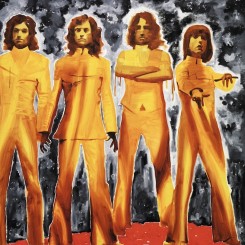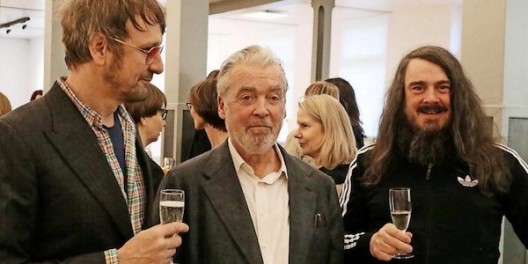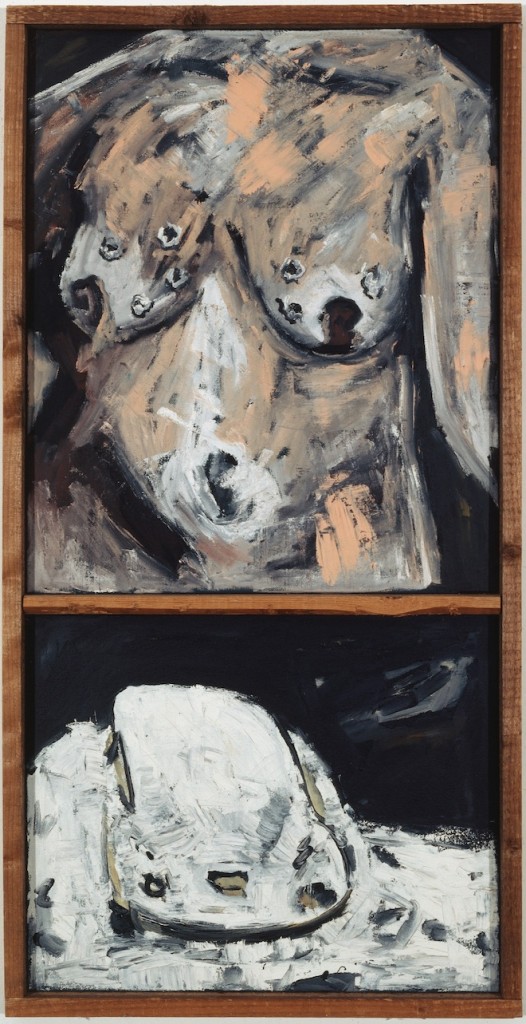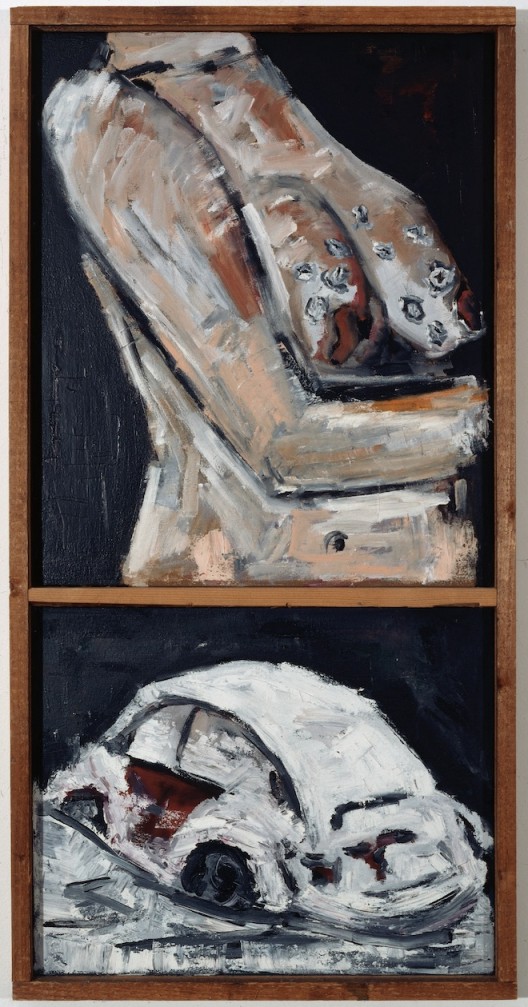by Thomas Eller
Werner Büttner, Wild Painter in Germany who changed the 1980s.
The eponymous artist Werner Büttner has been the intellectual figurehead of one of Germany´s most successful artists groups in the 80s. Together with Martin Kippenberger and Albert Oehlen he was shaking up postwar complacency (and complicity) in Germany at the end of Germany´s Wirtschaftwunder (economic wonder) and the cusp of the Cold War period between the USA and the USSR. The three-member boy group ripped apart comfortable truths and false convictions with their acerbic commentaries, radical ways of painting and their performative clout. They were the inventors of what became known in Germany as the “Bad Painting” movement (“bad” as in “bad-ass”, of course).
Recently the artistic work by Werner Büttner, who has been the teacher of many successful artists like Daniel Richter and Jonathan Meese, has been receiving surging interest in the market. Marlborough Gallery has given Büttner a lot of exhibitions and catalogs since 2016. CFA gallery in Berlin recently held two solo back-to-back exhibitions and Simon Lee Gallery has just announced its collaboration with Werner Büttner in the British market.
Thomas Eller met Werner Büttner in October in the artist´s studio in Geesthacht outside of Hamburg to talk about art, life and the un-sublime. In essence the question: Why make art?
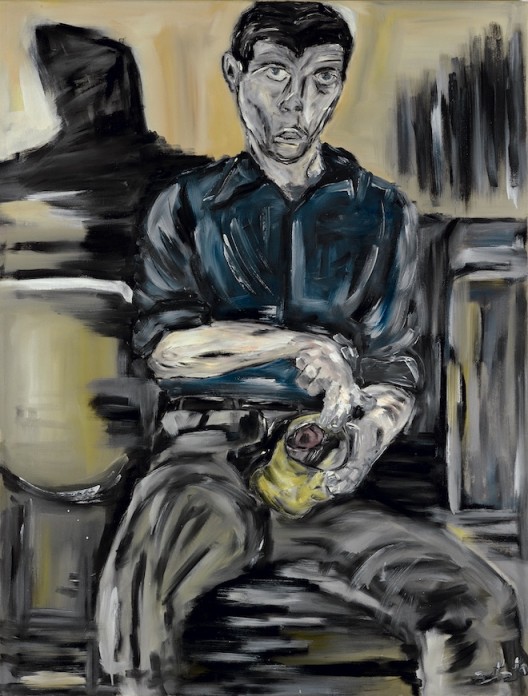
Werner Büttner, Self-Portrait Masturbating at the Cinema (Selbstbildnis im Kino onanierend), 1980
59,1″ × 45,3″ / 150 cm × 115 cm oil / canvas (image courtesy the artist)
Thomas Eller: Dear Werner Büttner, I’m afraid we need to begin at the very beginning. Let’s start not with Adam and Eve though, the first humans created by God, but with Cain and Abel, their first two sons, who have been a reoccurring motif in your paintings. According to the Bible, the brothers got into a fight over God’s favor. Cain, who was a farmer, was jealous of God’s apparent preference for Abel, who was a shepherd. So, Cain took a club and murdered Abel. Much has been read into this story, not least the sinfulness at the core of the human condition. But also, the ancient cultural struggle between hunter-gatherers and farmers with their different and conflicting lifestyles. Which are you, hunter-gatherer or farmer?
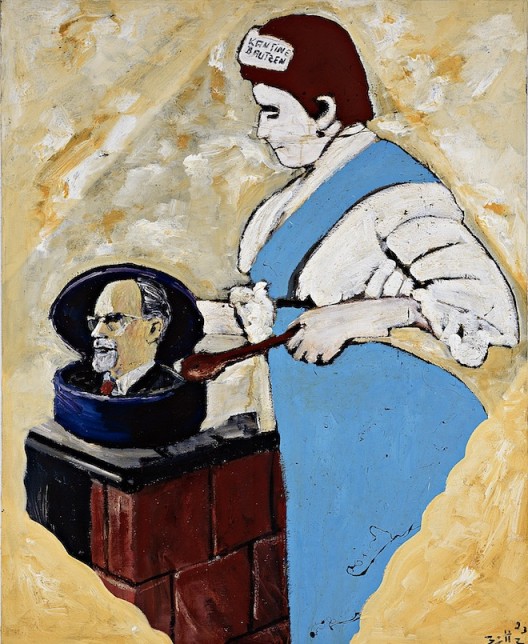
Werner Büttner, Bautzen Canteen Kantine Bautzen, 1993,
59,1″ × 47,3″ / 150 cm × 120 cm oil / canvas (image courtesy the artist)
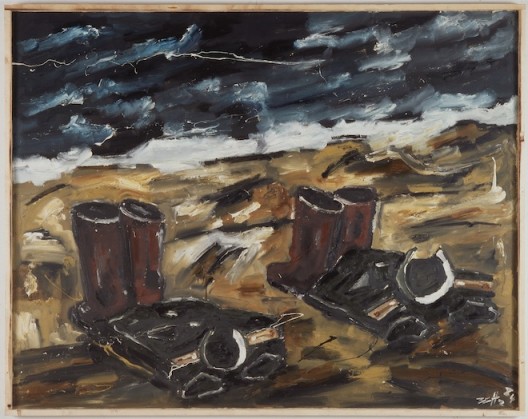
Werner Büttner, Bathing Russians II Badende Russen II, 1984
59,1″ × 74,9″ / 150 cm × 190 cm oil / canvas (image courtesy the artist)
Werner Büttner: I’m like the fowls of the air and the lilies of the field. I do not sow, nor do I reap, I tend no livestock, and yet the heavenly Father feeds me. According to the teachings of the Gnostics, this God is a bungling god. With his arbitrary rejection of Cain’s sacrifice, he incited him to murder his brother, plunging him into an existential depression that culminated in a fitting disaster: God doesn’t love me, ergo I shall kill my brother. Since then, many have followed this line of argument, and many brothers have been killed. And before you ask me if I’m a Gnostic: I merely admire their technique—the rebellious reinterpretation of common truths.
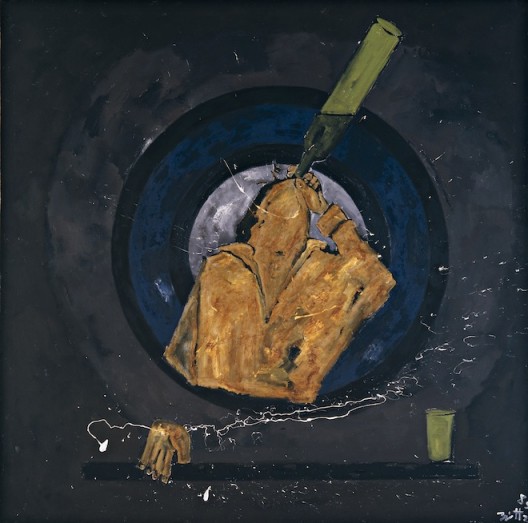
Werner Büttner, Thirst Durst, 1989,
74,9″ × 74,9″ / 190 cm × 190 cm oil / canvas (image courtesy the artist)
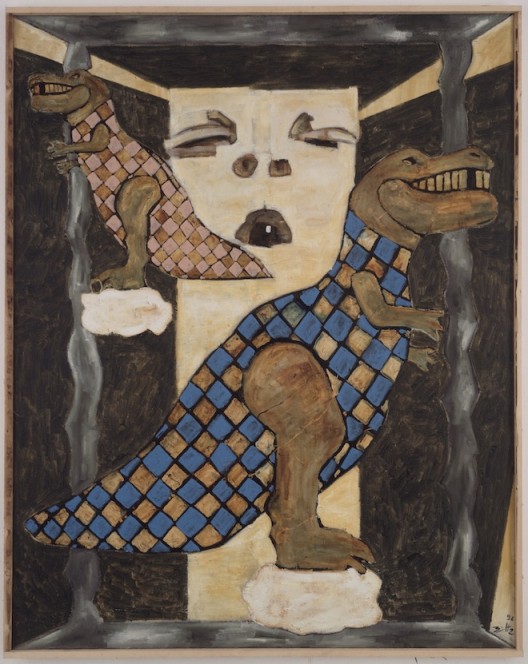
Werner Büttner, Is Humour a Concept of Nature? (Ist Humor ein Konzept der Natur?)
1992, 94,6″ × 74,9″ / 240 cm × 190 cm oil / canvas (image courtesy the artist)
THE: Lilies and birds—you’re quoting a famous Biblical verse where Jesus calls on people to lay up treasures in heaven and not on earth: “For where your treasure is, there will your heart be also.” And, to explain this to our readers: Gnosticism was an early Christian movement that was excluded from the orthodoxy of the church. In the practical and spiritual life of the community, for example, women played a far greater role than in the usual patriarchal societies of the time. As I understand it, in your life and in your art, you have combatted orthodoxy and sought out other paths wherever possible. But knowing that you never went to art school, that you studied law—the rules that provide a binding framework for our social life, defining what we may and may not do if we wish to avoid prison—knowing that this is what you studied raises the question: How do the two fit together?
WB: I studied law for two reasons. At the time, there were no admission requirements, and I had graduated from high school with poor grades. I would always miss the first two classes in the morning because I worked at the post office from 5 to 11 pm. I had left home at 16 and I had to earn money. And secondly, I thought law was philosophy applied in practice that would allow me to help underprivileged people out of tight spots. That was adolescent naivety. Then came the reality, with five thousand law students at the Free University in Berlin, most of them arrogant little bastards whose fathers and grandfathers had already been lawyers. That wasn’t the right company for me. And the professors were authoritarian cynics with dubious pasts. In the early 1970s, German universities had yet to undergo denazification. But this experience is not one I would want to be without. My three semesters of law reinforced my mistrust of human agreements, showed me how time-bound and arbitrary they are, be they laws, traditions, or customs. My engagement with ethnology also encouraged me to take a skeptical look at this. Max Stirner, who wrote the book The Ego and Its Own and founded individualist anarchism, put it like this: “I have set my cause on nothing.” In other words: only rely on things you’ve checked for yourself and found to be fit for your own use. Sometimes, that might be something unorthodox.
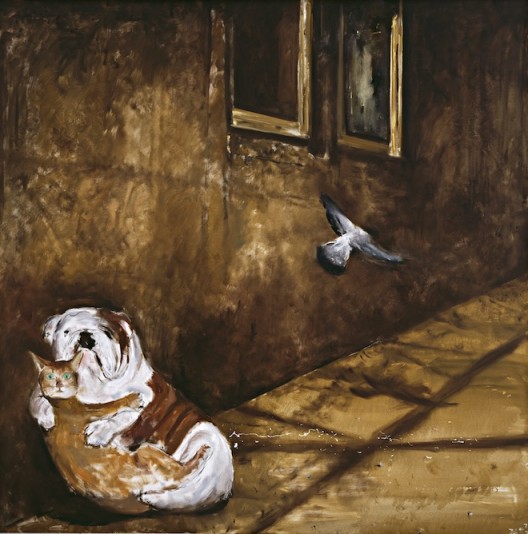
Werner Büttner, Everything Is So Wonderful to See, So Terrible to Be …
(Alles so herrlich zu sehn, und so schrecklich zu sein …), 2011,
74,9″ × 74,9″ / 190 cm × 190 cm oil / canvas (image courtesy the artist)
THE: As we know, you didn’t become a lawyer. Now for another question about beginnings: what was the path that brought you to art?
WB: It all began with a one-night stand. I was young, in my mid-twenties, in Berlin, and a woman took me back to her place. She lived in a shared flat and the next morning she opened the door and a billiard ball rolled slowly and menacingly across the floorboards. That was their in-house code and it meant: “Throw this guy out, Gunda, we want to have breakfast.” One of the people living there was Albert Oehlen and we became friends. We renovated flats together, and we spent three years talking about what remained to be done in art. Then we got down to work. In 1977, we moved to Hamburg together where Albert was accepted to study with Polke at the Academy. At the time, we saw Polke, Immendorff, and Beuys as the milestones. We talked about how to develop on from that, about what hadn’t happened yet. And then we got down to work.
THE: That sounds almost like a five-year plan. First talk, then act. Or as Martin Kippenberger, who you also collaborated with, once put it: “Think today, finished tomorrow.” But it can’t have been that easy. At the time, you were part of a “boy band” as it would be called later in the 1990s. What was it like with Oehlen and Kippenberger?
WB: Yes, I met Kippenberger in Hamburg, where Oehlen and I had moved to—Kippenberger just started to have his Berlin space, “Kippenberger’s Büro.” He had inherited money and bought work and put on shows. We knew we could shout louder if we were together, a group of young men exhibiting together was more powerful than just individual painters.
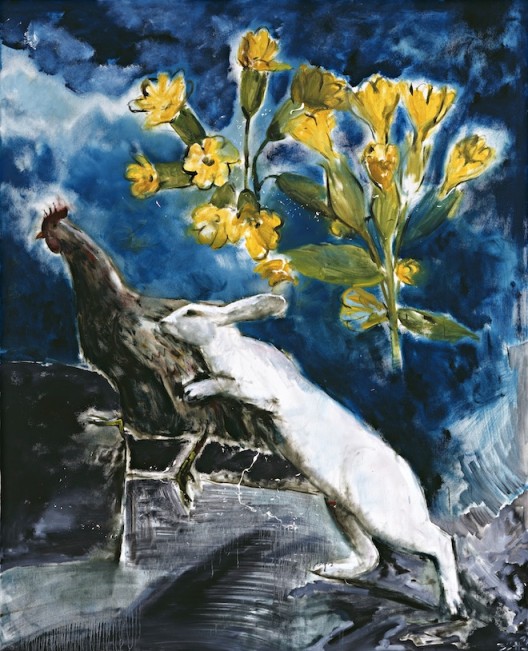
Werner Büttner, March Fever (Märzfieber), 2011
59,1″ × 47,3″ / 150 cm × 120 cm oil / canvas (image courtesy the artist)
THE: This was a difficult time in Germany. The NATO Double-Track Decision pretty much installed nuclear weapons in Germany. The ecological crisis, zero economic growth. The peace movement and the founding of the Green Party tried to find answers to this. But that wasn’t enough for some. There were communist splinter groups in every city, Maoists, anarchists. Some even took to violence like the Red Army Fraction (RAF) that began terrorizing the softened souls of West German TV audiences by actually killing politicians. At the same time, Nazi perpetrators still held office in the judicial system, in politics, and in academia. How was art an option for a group of young men at this time?
WB: What other options were there? Abandon hope, conform, go underground? None of that suited my brooding, contemplative, anti-active disposition. I preferred to comment on the mindlessness of it all from the comfort of my own home, from my studio. So, art was a perfect match for my apathy. At last, my loathing for human entanglements had found an acceptable outlet.
THE: With slogans like “Via Puberty To Success” and “Skilled Worker Fucking,” you stirred up the newfound ills of a post-fascist society. It seems to me that at the time, you had a daily competition with Kippenberger and Oehlen to see who could capture the absurdities of the world in the most effective form …
WB: Kippenberger called it “be smart, take part.” Not a bad understatement on his part, and free of pathos” At the time, sections of the youth were gripped by a frenzy of new departures, presumably as a result of silence concerning the Nazi dictatorship. Music and fine art were the worst affected, as brazen amateurs successfully assaulted the canon. Sustained by an arrogance that found its justification in the guilt of the old and all those who sailed with it, the new was punched blinking into the world. Some resorted to guns and were punished. Others cried “Back to concrete!” Others still said, “No thank you!”(1) to this and to that. And some contented themselves with sedatives from Amsterdam. Irreparable damage was done to the nuclear family, obedience to authority, and the Humboldtian model of higher education. Using grammatical forms of politeness also became suspect. At the time I, too, wanted nothing more than to be heard and seen and to be put to bed by the right persons. What drew Kippenberger and me to each other? At some point in the 1980s we realized that we’d put people like Harald Schmidt (a German TV personality of questionable ethical standing) into positions of power, and that it was time for us to think of something new.
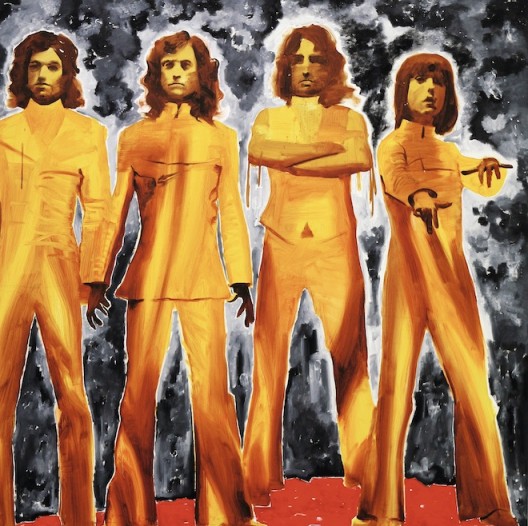
Werner Büttner, Singing Men (Singende Männer), 2005
74,9″ × 74,9″ / 190 cm × 190 cm oil / canvas (image courtesy the artist)
THE: “We read the newspapers in the morning and paint in the afternoon. The results are the responsibility of the state.” This sounds like caustic irony. The art you were making at the time was fast and furious. The pictures had to be finished within a single day.
WB: Back then, I painted as best I could, so yes, there are bold, rough parts. A lot of it was hastily done, I didn’t want to spend all day in front of a canvas, I had better things to do. I worked a lot in alla prima, painting wet-on-wet. I also hated signing pictures, so I tried to create elements that made my work recognizably my own. The dribbled paint, the use of black, so that people would spot my work and say: “This is a Büttner.” And it worked! But I was very much concerned with what I was painting. Take a look at my painting Bathing Russiansfor example. Here I show the soldiers’ uniforms, neatly folded near the seashore. You don’t see the soldiers. They’ve gone swimming. In German we have the expression baden gehen, literally to go swimming, meaning: you lose touch and become unsuccessful. And that was what was going to happen to Russia. I made the painting in 1982 and three years later they were dead in the water. In my opinion the Soviet Union collapsed on May 17, 1985—the day Gorbachev attempted to ban alcohol. That was the breaking point.
THE: You were born in the German Democratic Republic but grew up in West Germany. How was life under the dictatorship of the proletariat?
WB: The policemen were friendly, as were the informers, and I was a socialist bundle of joy. Sometimes I think if we’d stayed in the GDR, if my mother hadn’t kidnapped me and taken me to the West, then in 1989 I’d have been Egon Krenz (East Germany’s last head of state) and I’d have been a bit tougher about selling off the GDR. However, two months before the Berlin Wall was built, in June 1961, my mother kidnapped me. My father had already fled. He wanted to be rid of us, which my mother couldn’t accept, unfortunately. She took three helpless children and followed him. That was more or less the greatest achievement of her life. After the little family was reunited, my parents terrorized each other and she was the first to die, aged 52. So it was a shabby misalliance from which I emerged.
THE: You even made art about this, didn’t you?
WB: The picture On Thrownness and Entanglement shows me aged two on a pony against the background of a blown-up postcard of my hometown, Jena. Definitely a biographical statement. But the title points to the calamities of any existence. According to Martin Heidegger, we are thrown into being by an unknown power, into a “being-toward-death.” In such an existence we are perpetually afraid, and this fear becomes a being-toward-nothing. Heidegger’s rather touching way out of this human dilemma is, in short, the freely designed life plan of each individual. He overlooks the fact that one is also thrown into entanglements that seriously impede the being-towards-life-plan. One is thrown into a family, into a historical period, and, worse still, into a zeitgeist, into political and social orders of uncertain quality and duration, plus, if one is really unlucky, into an ice age or a global economic crisis. The freedom to plan one’s life is thus intrinsically occasionalist. And this is an insight one must endure. But I don’t go to Jena anymore, as it looks like any other city now. Everything’s the same, same petrol stations, same shopping malls. I have no relatives there anymore, either. Now I’m a widower and an orphan and that’s it. As Schopenhauer said, you have to love your solitude, it’s the only way to happiness.
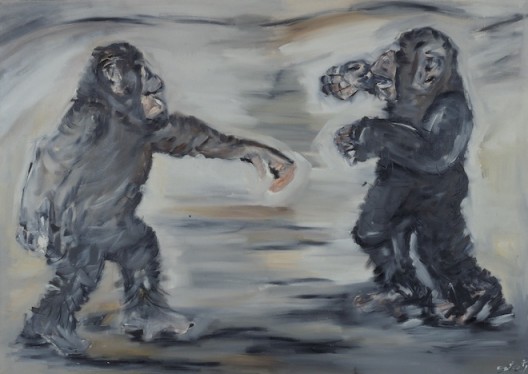
Werner Büttner, For They Know How to Behave I (Denn sie wissen was sich gehört I), 1981,
49,3″ × 70,9″ / 125 cm × 180 cm oil / canvas (image courtesy the artist)
THE: But can we come back to “read in the morning, paint in the afternoon.” There’s more …
WB: No, there’s nothing more than opening your eyes, really opening them. And when you do open them, it keeps you awake at night. What you see hurts, and you want to strike back. And, to put it cryptically, you become a sieve through which your surroundings are shaken. Information from your environment gets stuck in the sieve in pieces of precisely the size you ordered. And now you can work, now you can strike back …
THE: “Truth Is Work” was the title of the exhibition you did in 1984 with Kippenberger and Oehlen at the Folkwang Museum in Essen. Was it a book or a manifesto.
WB: It was everything. Zdenek Felix, then director of the Folkwang Museum, had a great deal of faith in Albert and me. We were able to realize the book entirely on our own, and right to the end he didn’t know what he was going to get. For two thirty-year-olds putting on their first museum show, that’s a risky leap of faith. And of course, we understood “Truth Is Work” as one long manifesto, as a cry of “here we are, ready to take over.” A ruthless commentary on the world and the art of the time in crude pictures and texts. Work was not yet on the red list of endangered species. But Margaret Thatcher and Ronald Reagan were already letting financial capitalism off the leash. Due to the lingering illness and subsequent death of socialism, there was then allegedly no alternative to capitalism. And being without any alternative is probably the best thing that can happen to you. As a young person at that time, one was “genetically” left-wing, with a vague romantic love of the working class and of “the downtrodden and the slighted.” Maybe due to a guilty conscience, because as an artist one was exempt from hard, alienated labor, having exempted oneself from it. And artists suddenly started talking about their artistic “labor.” In the United States and Britain there were bloody miners’ strikes, and Martin Kippenberger’s father was the director of a mine. Perhaps that’s why we had the miner’s hammer and pick on the cover of “Truth Is Work,” although they were surrounded by flies. And flies always gather wherever there’s a strong smell. It should probably say: “We’re still not through with what we have to do.”
THE: In the catalog, you write: “We hate the truth because it is one of the dirtiest birds in the world.” After the Death of God (Friedrich Nietzsche) there’s not much left. And back to Max Stirner, the ego-anarchist. What always interested me most in your early work were the self-portraits: The Artist Takes A Chamomile Steam Bath (Der Künstler beim Kamilledampfbad) or Self-Portrait Masturbating At The Cinema. Eckhard Gillen describes you as a “modern Cynic,” a figure described in the late 1980s by the philosopher Peter Sloterdijk as someone who is “as modest in needs as a dog.” This school of philosophy founded by Antithenes strove for a humble life free of needs that despised all culture and public morals and was thus viewed as shameless.
WB: The Cynics certainly were a remarkable bunch, probably the earliest known performance artists. “Diogenes the dog” masturbated in the marketplace and then said, “If only it were so easy to soothe hunger by rubbing an empty belly!” This is a magnificent piece of theatre, well worth passing down to future generations. In a small action, many explosive elements are concealed. At the same time, beauty and the sublime are given a passing slap in the face.
THE: In this context, you have spoken of “non-sublime motifs.” What do you mean by that?
WB: Painting has always had clear subject categories: religion, landscape, history, hunting, still life, nude, self-portrait, et cetera. And the artistic avant-gardes of the last century continued to accept some of them. The only new subject they added was worldlessness. The irrefutable founding formula of this category was: “Art is art and everything else is everything else.” This led to an elegance that was risk-free, unassailable, and insufficiently complex. The vain shabbiness of the human condition was bypassed – [it was just] extra -terrestrial wallpaper. And in some cases, overwhelming in its lofty ignorance. But that was not my path. I preferred to remain in the world. And I expanded my range of subjects via behavioral research and sociology. Kaspar Hauser Ducks Follow A Decoy or Strangely, The Hate Of The Lumpen Proletariat Is Directed Towards Telephone Boxes are examples. Bathing Russians and Storming The Bastille were farewells to bombastic history painting. Every morning, I’m amazed at the funfair of earthly phenomena and I feel obliged to manically comment on them…
THE: In other words: La condition humaine. I’m still not sure if you’re being ironic or whether you’re just good at hiding behind an ironic position. Kippenberger was someone who could make fun of everything with his swift wit.
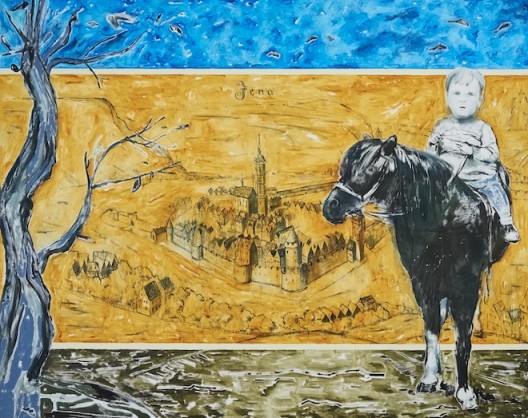
Werner Büttner, On Thrownness and Entanglement (Von Geworfenheit und Verstrickung), 2017, 74,9″ × 94,6″ / 190 cm × 240 cm, oil / canvas (image courtesy the artist)
WB: Kippenberger didn’t choose irony as his survival strategy. Free of ideology, he hit out in all directions in search of fun, love, and family connections in the art world. His work has improved with age, becoming a valid handbook for the eternal return of the banality of human beings.
THE: A number of people have said that you were the intellectual in your boy band with Kippenberger and Oehlen.
WB: You said that, not me.
THE: I think you know it came from a major collector. But to return to Cain and Abel and the beginning of our conversation—that’s a story about brothers competing for recognition.
WB: It wasn’t genuine competition because the great film director (God!) had already decided how the story would end. Ultimately, this ironie majeure was pure treachery, which is why the Gnostics called the “director” a fool and a bungler. By contrast, human irony is a sharp instrument of aesthetics. No one would criticize the plays of Aristophanes or In Praise of Folly (1509) for their use of ambiguity and their inherent laughter. Irony has the greatest distance to its object of inquiry. It is the stylistic device of the productively alienated. Only those who feel out of place in the world can be productively astonished. Those who are too close, involved, in agreement, can neither see clearly nor paint a clear picture.
END NOTES
1. “Atomkraft – Nein Danke!” – “Nuclear energy – No thank you!” was the slogan of the green movement in Germany
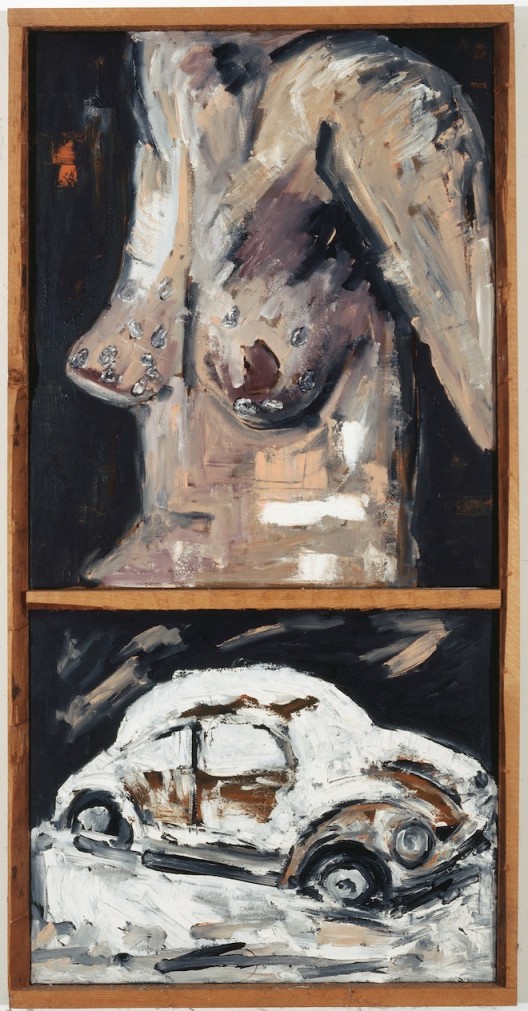
Werner Büttner, Small Sagging Bust Covered in Fingerprints and a Snow-Covered VW 3
(Kleiner Hängebusen voller Fingerabdrücke und verschneiter VW 3), 1982
39,4″ × 19,7″ / 100 cm × 50 cm oil / canvas (image courtesy the artist)

